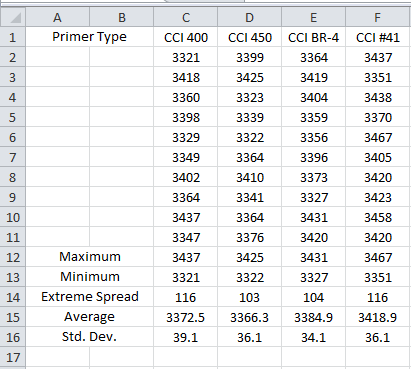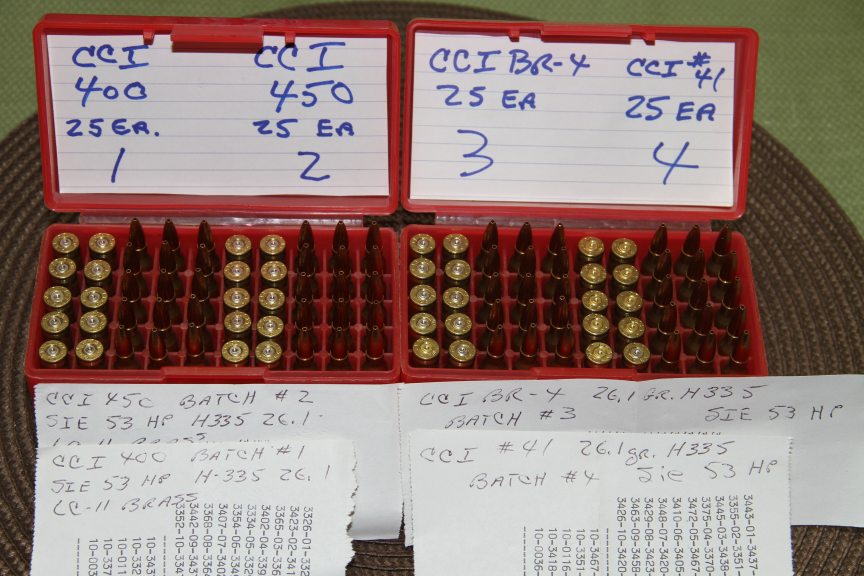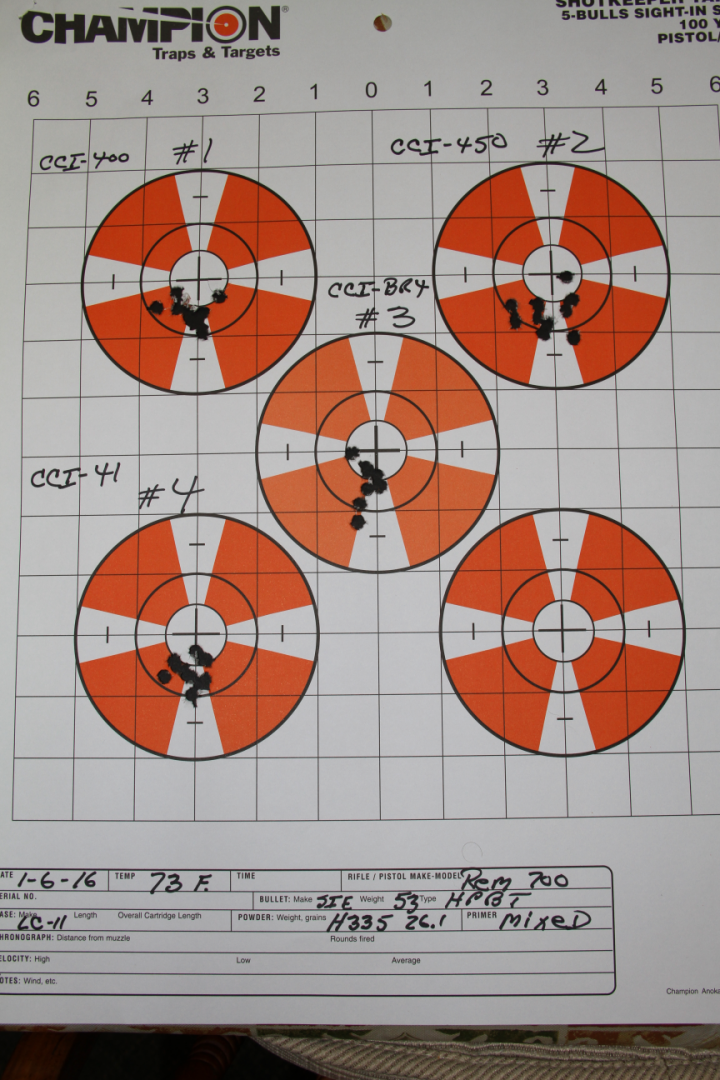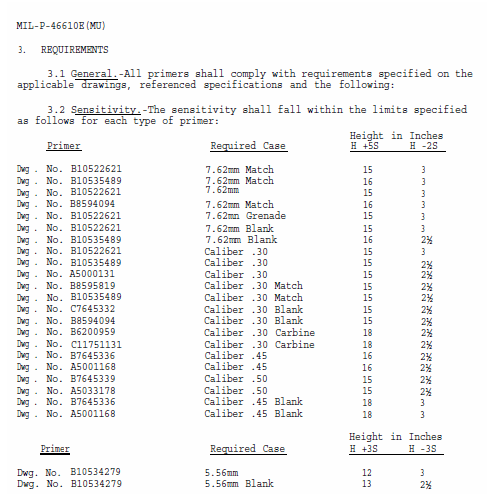Still experimenting /testing different recipes for .223 Remingtons out of an 16" AR. I previously used CCI #41 primers which are supposed to be made for ARs. I just bought some CCI BR-4s and CCI Small Rifle - magnum primers to use for 23.1 grains of IMR-4064 and 26.0 grains of CFE-223 over 55 and 62 grain FMJ-BT projectiles. They are loaded, but I probably won't be able test for a couple of weeks. Any educated opinions whether there will be any significant differrnces in velocity and cleanliness of the burn?
You are using an out of date browser. It may not display this or other websites correctly.
You should upgrade or use an alternative browser.
You should upgrade or use an alternative browser.
Another primer question
- Thread starter DMY
- Start date
turtlehead
New member
I've been using CCI 400s with 26.3 CFE223 and 55 gr Hornady fmjbt for a few months now in one of my ARs. I actually have noticed the rifle has never run cleaner. Just my sample of one FWIW.
During June of this past summer I did some experimenting with CCI primers. I loaded 100 rounds using identical brass (LC 11) using Hodgdon H 335 powder with a 26.1 grain charge below a Sierra 53 grain match bullet. All cases were trimmed to an equal 1.750" and loaded to and equal 2.250" C.O.A.L.
The primers used were CCI 400, CCI 450 Magnum, CCI BR-4 Bench Rest and CCI #41. The CCI 400 and 450 are Standard and Magnum small rifle respectively.
CCI #41:
CCI BR-4:
The data on the CCI BR-4 would lend me to believe the primer is a Standard (non magnum) type primer but in another thread another member who I have utmost respect for suggested they may be a magnum primer. I sent an email to CCI who normally replies within a week.
Here are the results of my test shooting ten shot groups with the 4 different primers I mentioned. The results were somewhat surprising. Also while I did shoot a target my goal was not target accuracy but getting all my shots over my chronograph sky screens evenly.
The Velocity Data:

The loaded ammunition divided up with the chronograph printouts.

Finally the target which was shot at 100 yards:

Again I was not shooting for accuracy on the target but overall the CCI #41 primers delivered the best ten shot group. I would have expected the BR-4 to group best. Also note the velocities, the BR-4 primers delivered the fastest average velocity. As another mentioned, the BR-4 sure acted like a magnum primer. Anyway, you have some data to compare and please do post your findings. When I get something definitive from CCI as to their BR-4 I will post that.
On a side note my old Speer #12 loading manual, when loading .223 Remington using the ball propellant H 335 does call out the use of a magnum primer which is pretty common. The use of a magnum primer when using a ball or spherical powder as the propellant. I will be curious to see what your findings are.
Finally I should mention my test rifle was an old custom Remington 700 with a 26" barrel having a 1:12 twist. Never got to run this test using a heavier bullet in my AR rifles.
Ron
The primers used were CCI 400, CCI 450 Magnum, CCI BR-4 Bench Rest and CCI #41. The CCI 400 and 450 are Standard and Magnum small rifle respectively.
CCI #41:
Mil-spec sensitivity
Initiator mix optimized for ball/spherical propellants
Available in large (No.34) and small (No. 41) rifle
Use the same data as CCI Magnum primers
CCI BR-4:
Incredibly consistent ignition power
Selected metal parts
Each primer marked with a “B” for quick
identification
Use the same data as CCI Standard (non-Magnum)
primers
The data on the CCI BR-4 would lend me to believe the primer is a Standard (non magnum) type primer but in another thread another member who I have utmost respect for suggested they may be a magnum primer. I sent an email to CCI who normally replies within a week.
Here are the results of my test shooting ten shot groups with the 4 different primers I mentioned. The results were somewhat surprising. Also while I did shoot a target my goal was not target accuracy but getting all my shots over my chronograph sky screens evenly.
The Velocity Data:

The loaded ammunition divided up with the chronograph printouts.

Finally the target which was shot at 100 yards:

Again I was not shooting for accuracy on the target but overall the CCI #41 primers delivered the best ten shot group. I would have expected the BR-4 to group best. Also note the velocities, the BR-4 primers delivered the fastest average velocity. As another mentioned, the BR-4 sure acted like a magnum primer. Anyway, you have some data to compare and please do post your findings. When I get something definitive from CCI as to their BR-4 I will post that.
On a side note my old Speer #12 loading manual, when loading .223 Remington using the ball propellant H 335 does call out the use of a magnum primer which is pretty common. The use of a magnum primer when using a ball or spherical powder as the propellant. I will be curious to see what your findings are.
Finally I should mention my test rifle was an old custom Remington 700 with a 26" barrel having a 1:12 twist. Never got to run this test using a heavier bullet in my AR rifles.
Ron
DMY,
The #41's are made to military sensitivity specifications, which are for lower sensitivity because the floating firing pin weapons tend to indent primers at least a little when chamber a round. Using lower sensitivity helps prevent slamfires, though as far as I know, the AR system isn't nearly as prone to them as the Garand and M14/M1A mechanisms are. CCI told me the #41 is identical to the CCI 450, except the anvil is made with a wider leg angle to reduce sensitivity to military levels.
If you don't want a magnum primer, Federal makes the GM205MAR, which is the same as their 205M match primer, except the sensitivity is reduced to military levels, in this instance, Federal told me, by using a thicker cup.
The military spec is below. It's for the H test (height test) in which a 4.0 ounce ball is dropped onto a firing pin. None are supposed to fire when it is dropped from a height of 3" and all must fire when it is dropped from a height of 15 inches. At least, that's the basic idea Hatcher set forth. The spec below instead puts this in terms of standard deviations from the 50% firing height of the ball and at different test heights to ensure compliance.

The #41's are made to military sensitivity specifications, which are for lower sensitivity because the floating firing pin weapons tend to indent primers at least a little when chamber a round. Using lower sensitivity helps prevent slamfires, though as far as I know, the AR system isn't nearly as prone to them as the Garand and M14/M1A mechanisms are. CCI told me the #41 is identical to the CCI 450, except the anvil is made with a wider leg angle to reduce sensitivity to military levels.
If you don't want a magnum primer, Federal makes the GM205MAR, which is the same as their 205M match primer, except the sensitivity is reduced to military levels, in this instance, Federal told me, by using a thicker cup.
The military spec is below. It's for the H test (height test) in which a 4.0 ounce ball is dropped onto a firing pin. None are supposed to fire when it is dropped from a height of 3" and all must fire when it is dropped from a height of 15 inches. At least, that's the basic idea Hatcher set forth. The spec below instead puts this in terms of standard deviations from the 50% firing height of the ball and at different test heights to ensure compliance.

Results of my primer comparison
Thanks for your responses and data. I'm probably cluttering my feeble mind with data which may or may not be of use to me, however, I find all of your results very interesting. I'm confident that I speak for many of the lurkers out there that Uncle Nick, Reloader Ron (Nick C_S_, GWillikers and others) have probably forgotten more than I will ever know. Additionally, both my equipment and I are far from being tack drivers, but I do enjoy the chase.
That being said, I had the following results from my primer comparison. Most of the results were during one session in the rain, 55 degrees, 2-5 mph head wind, chronograph set up 12 yds from the 1:7 twist non-lined barrel, using Fiocchi (GFL) brass in .223 Rem, trimmed to 1.750". The readings with the asteriks are from a prior session using Winchester brass and similar rainy conditions. The primers tested are all manufactured by CCI: BR-4; small rifle-magnum (SR-M); and #41 on the same day and #41 from a prior session. I realize my sampling size is relatively small, but it is what it is.
Hornady 55 gr FMJ BT:
(1) 26.0 grs CFE-223:
(A) BR-4 primer: ave 2714.5 fps (10 shots); ES 111 fps; SD 37.75.
(B) SR-M primer: ave 2714.4 fps (10 shots); ES 73 fps; SD 28.75.
(C) #41 primer: ave 2743.2 fps (5 shots); ES 73 fps; SD 28.75.
(D) #41-primer*: ave 2623 fps (10 shots); ES 113; SD 41.7.
(2) 23.1 grs IMR 4064:
(A) BR-4 primer: ave 2436.9 fps (10 shots); ES 144 fps; SD 48.21.
(B) SR-M primer: ave 2397.6 fps (5 shots); ES 136 fps; SD 53.19.
(C) #41 primer: ave 2489.0 fps (5 shots); ES 145 fps; SD 55.62.
(D) #41 primer*: ave 2466 fps (5 shots); ES 45 fps; SD 17.
Hornady 62 gr FMJ BT:
(3) 26.0 grs CFE-223:
(A) BR-4 primer: ave 2744.5 fps (10 shots); ES 85 fps; SD 31.68.
(B) SR-M primer: ave 2696.5 fps (10 shots); ES 137 fps; SD 40.82.
(C) #41 primer: ave 2740.4 fps (5 shots); ES 23 fps; SD 10.57.
(4) 23.5 grs IMR 4064:
(A) BR-4 primer: ave 2519.8 fps (10 shots); ES 110 fps; SD 32.93.
(B) SR-M primer: ave 2507 fps (10 shots); ES 23 fps; SD 10.57.
(C) #41 primer: ave 2530.8 fps (5 shots); ES 53 fps; SD 35.8.
(D) #41 primer*: ave 2549 fps (10 shots); ES 117 fps; SD 41.4.
There were no signs of excessive pressure. The CFE loads were closer to the high end of the range, a little snappy and burned cleaner than the IMR 4064 which was not that dirty and had very soft recoil. Like Ron, I was concentrating less on accuracy than trying to center the projectile in the middle of the chronograph field. However, my groups were pretty much typical for me (3 shots >1" and 5 shots >2" with open sights at 50 yds.) I can't say that the few loads with low ES and SD grouped any tighter, but it could easily be attributible to the shooter.
Thanks again for everyone's input. It gives me another thing to ponder.
Thanks for your responses and data. I'm probably cluttering my feeble mind with data which may or may not be of use to me, however, I find all of your results very interesting. I'm confident that I speak for many of the lurkers out there that Uncle Nick, Reloader Ron (Nick C_S_, GWillikers and others) have probably forgotten more than I will ever know. Additionally, both my equipment and I are far from being tack drivers, but I do enjoy the chase.
That being said, I had the following results from my primer comparison. Most of the results were during one session in the rain, 55 degrees, 2-5 mph head wind, chronograph set up 12 yds from the 1:7 twist non-lined barrel, using Fiocchi (GFL) brass in .223 Rem, trimmed to 1.750". The readings with the asteriks are from a prior session using Winchester brass and similar rainy conditions. The primers tested are all manufactured by CCI: BR-4; small rifle-magnum (SR-M); and #41 on the same day and #41 from a prior session. I realize my sampling size is relatively small, but it is what it is.
Hornady 55 gr FMJ BT:
(1) 26.0 grs CFE-223:
(A) BR-4 primer: ave 2714.5 fps (10 shots); ES 111 fps; SD 37.75.
(B) SR-M primer: ave 2714.4 fps (10 shots); ES 73 fps; SD 28.75.
(C) #41 primer: ave 2743.2 fps (5 shots); ES 73 fps; SD 28.75.
(D) #41-primer*: ave 2623 fps (10 shots); ES 113; SD 41.7.
(2) 23.1 grs IMR 4064:
(A) BR-4 primer: ave 2436.9 fps (10 shots); ES 144 fps; SD 48.21.
(B) SR-M primer: ave 2397.6 fps (5 shots); ES 136 fps; SD 53.19.
(C) #41 primer: ave 2489.0 fps (5 shots); ES 145 fps; SD 55.62.
(D) #41 primer*: ave 2466 fps (5 shots); ES 45 fps; SD 17.
Hornady 62 gr FMJ BT:
(3) 26.0 grs CFE-223:
(A) BR-4 primer: ave 2744.5 fps (10 shots); ES 85 fps; SD 31.68.
(B) SR-M primer: ave 2696.5 fps (10 shots); ES 137 fps; SD 40.82.
(C) #41 primer: ave 2740.4 fps (5 shots); ES 23 fps; SD 10.57.
(4) 23.5 grs IMR 4064:
(A) BR-4 primer: ave 2519.8 fps (10 shots); ES 110 fps; SD 32.93.
(B) SR-M primer: ave 2507 fps (10 shots); ES 23 fps; SD 10.57.
(C) #41 primer: ave 2530.8 fps (5 shots); ES 53 fps; SD 35.8.
(D) #41 primer*: ave 2549 fps (10 shots); ES 117 fps; SD 41.4.
There were no signs of excessive pressure. The CFE loads were closer to the high end of the range, a little snappy and burned cleaner than the IMR 4064 which was not that dirty and had very soft recoil. Like Ron, I was concentrating less on accuracy than trying to center the projectile in the middle of the chronograph field. However, my groups were pretty much typical for me (3 shots >1" and 5 shots >2" with open sights at 50 yds.) I can't say that the few loads with low ES and SD grouped any tighter, but it could easily be attributible to the shooter.
Thanks again for everyone's input. It gives me another thing to ponder.
Now this is my opinion from my testing of primers.
First of all to make it clear. Accuracy is what I want and the primer can make it or break it. I will try my favorite powder with bullet combo. Then load 5-10 rounds with every compatible primer I have. Remember I want a tight group for accuracy.
The velocity is not my concern. The bullet design has all ready been worked out for use and proven to give me the best accuracy I can get. I'm not changing any thing not even the choice cases. Pockets have been uniformed.
Powder is the best I have been able to find with the package.
That is when I will test primers. I have found that Remington #7 1/2 work best for me. That doesn't mean it will be best for your gun... combination.
I don't locally have a big selection of primers so that's where I limit my self.
When I find the primer that works best for me I then pick up 1000...
First of all to make it clear. Accuracy is what I want and the primer can make it or break it. I will try my favorite powder with bullet combo. Then load 5-10 rounds with every compatible primer I have. Remember I want a tight group for accuracy.
The velocity is not my concern. The bullet design has all ready been worked out for use and proven to give me the best accuracy I can get. I'm not changing any thing not even the choice cases. Pockets have been uniformed.
Powder is the best I have been able to find with the package.
That is when I will test primers. I have found that Remington #7 1/2 work best for me. That doesn't mean it will be best for your gun... combination.
I don't locally have a big selection of primers so that's where I limit my self.
When I find the primer that works best for me I then pick up 1000...
Just for clarification I posed the following question to CCI:
"Would the CCI BR-4 Primer be classified as a Standard or Magnum small rifle primer? Likewise the CCI #41 primer, would it be Standard or Magnum classified?
Thank You"
Here is the reply:
So for future reference the CCI #41 is classified as a small rifle magnum primer and the CCI BR-4 is classified as a standard primer.
Ron
"Would the CCI BR-4 Primer be classified as a Standard or Magnum small rifle primer? Likewise the CCI #41 primer, would it be Standard or Magnum classified?
Thank You"
Here is the reply:
Ronald, primer specifications are below.
Small rifle primers
#41......................................Mil. Spec. primer, thick cup, magnum primer charge, angle of anvil change.
BR4.....................................thick cup, standard anvil and standard priming mix held to a tighter tolerance.
So for future reference the CCI #41 is classified as a small rifle magnum primer and the CCI BR-4 is classified as a standard primer.
Ron
Since you are talking about primers a few months ago I was given loading equip from a friend. Small pistol and large pistol primers were included in this
approx 5K of each. Also included were CCI 550 Sm pistol magnum and CCI 350 large pistol magnum (1K of each). I'm loading primarily 45acp, 38/357, 9mm and .223 and I have everything for 44 mag. My question is what can these primers be used for?
approx 5K of each. Also included were CCI 550 Sm pistol magnum and CCI 350 large pistol magnum (1K of each). I'm loading primarily 45acp, 38/357, 9mm and .223 and I have everything for 44 mag. My question is what can these primers be used for?
